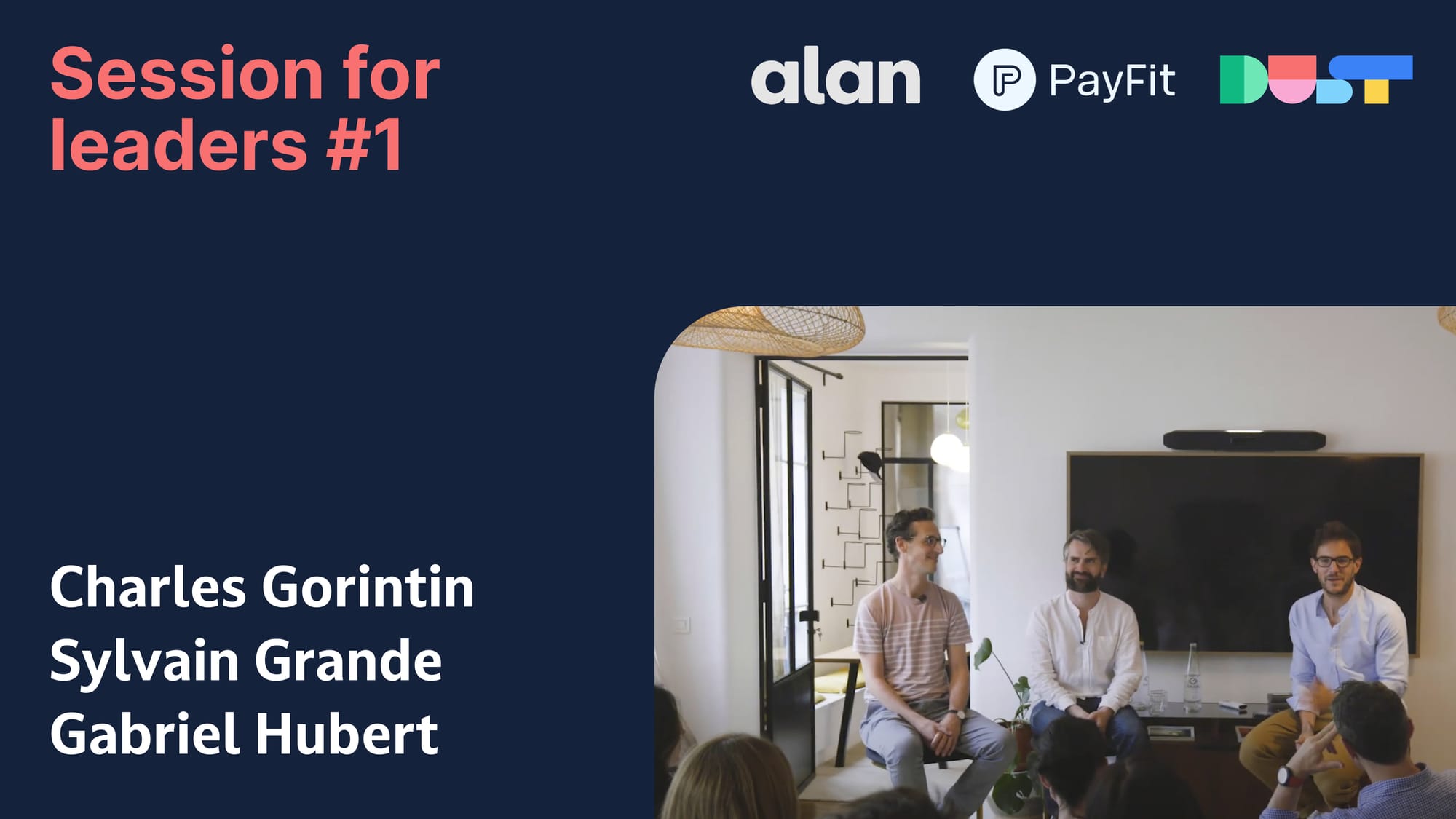20%+ productivity gains in Sales: Insights from Alan and Payfit on GenAI Implementation

On July 11th, we hosted our inaugural event for leaders convinced by the potential of Generative AI (GenAI) to grow and accelerate their companies. The event featured a fireside chat with Charles Gorintin, CTO of Alan, and Sylvain Grande, Chief Product Officer of Payfit, led by Gabriel Hubert, Co-founder and CEO of Dust. The discussion explored their approaches to the build vs. buy decision, favorite use cases, challenges, and ROI measurement. You can watch the full replay at the end of this post, but I'll share the key learnings below.
About Our Guests
Alan, founded in 2016, is a health tech company with 600 employees. It provides health insurance for over 25,000 companies, covering approximately 500,000 people across France, Spain, and Belgium. Charles Gorintin, Alan's co-founder and CTO, is also a non-executive founding member of Mistral.
Payfit, a payroll and HR software company, serves about 16,000 clients primarily in France, Spain, and the UK. The company generates roughly 250,000 pay slips monthly, focusing on simplifying payroll for non-experts. Sylvain Grande joined as Chief Product Officer two years ago, bringing experience from various COO, CRO, and VP Product roles at companies across Europe and the US, including SoundCloud, Shutterstock, and Yieldstreet.
Implementing GenAI Across Teams
Both Charles and Sylvain shared insights on their implementation strategies:
Charles emphasized Alan's goal of having 100% of employees use GenAI in their daily work. They found that detractors were often those who hadn't tried the technology, so they focused on making adoption as simple as possible. Charles noted,
"What matters to reach this goal is a combination of top-down vision and bottom-up adoption: you need the leadership to fully support/dedicate time for implementation AND to let the specific use cases emerge from people on the ground."
Alan's approach: "Make it simple and make it cool. Choose tools that are intuitive. Use them yourself, market what you do with them internally. Ultimately, this is what will drive adoption."
Today, over 80% of employees use AI and Dust weekly at Alan.
Sylvain described Payfit's focused approach: "When we launched Dust, we focused on our core business priorities first - Customer support at the time. We thoroughly measured gains to make sure we were doing the right thing." They identified key teams and AI champions (3-5 people per team) to drive adoption and educate others. Sylvain added, "Then we let other use cases bubble up naturally from other areas of the company. All teams are not fit for it. But you need to keep some room for high creativity to fully benefit from the technology."
The Build vs. Buy Decision
Both companies experimented with building Dust-like products internally before deciding to buy. They concluded that the initial investment and maintenance costs outweighed the competitive gains. Charles Gorintin referred to Dust as a "meta-platform.” He explained that its aggregation approach offered Alan flexibility, allowing them to leverage multiple data sources across tools and avoid being locked into specific tools or vertical ecosystems.
Favorite Use Cases with Dust
Sylvain focused on customer support at Payfit: "We use Dust both for direct ticket resolution and to support investigation for more complex queries. We actively measure and aim for 20% productivity gain here." He also mentioned HR applications like job description generation and performance reviews, noting that the latter is "an amazing use case to start. It is not very tough to crack, concerns everyone, and allows for sizeable and immediate time gains."
Charles highlighted sales process automation: "We have Dust agents that do account summaries, meeting transcriptions, CRM updates, follow-up email generation... This allowed Alan to reach 20%+ productivity gains in Sales and Marketing (because standardized Sales notes mean less work to surface intel for marketers as well!)." This significantly lowered their acquisition cost, allowing them to hire more salespeople.
Both leaders mentioned content creation, from SEO optimization to meeting summaries, as high-impact, fast-return use cases.
Models and Challenges
Sylvain identified key challenges:
- Keeping up with rapidly evolving AI models and capabilities: "You have to accept to be short-sighted."
- Balancing fragmentation of tools and data sources with use case specialization: "There is no one-size-fits-all; you have to iterate."
Charles highlighted:
- Security and compliance: "It's hard to fully avoid shadow IT and have bullet-proof data privacy when employees use external AI tools. So you need to have internal tools that are as nice to use as public options to discourage risky behavior."
- Consistency in performance beyond initial demos: "It's easy to make a great demo with GenAI, but much harder to have consistent quality in outcome. You want to build strong frameworks to keep retention up."
Productivity Gains and Future Outlook
Both Charles and Sylvain were optimistic about productivity gains. Sylvain sees "20%+ and more in certain areas. Some specific use cases (e.g., content writing, SEO) report up to 50% productivity improvements already."
Charles believes 50% productivity gains are possible, noting, "What's interesting and challenging is that the cultural adoption of AI is currently slower than the technological advancements. So it's a great time to focus on the first."
As we continue to explore the potential of GenAI in transforming how teams work, we hope events like this provide valuable insights into real-world implementation strategies and outcomes to our community. We're excited to see how companies like Alan and Payfit are making the Dust platform theirs to drive significant gains. We are excited as much as we are proud to support more organizations on their AI journeys and to keep building Dust for all their teams.

